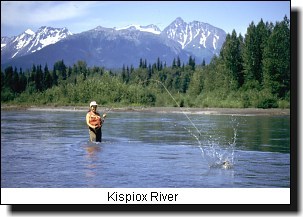|
|
|
List of BC Adventure Advertisers Site Info
Advertise With UsAwards About Us Contact Us  Kayak with Killer Whales Free Vacation Guides
BC Vacation GuidesCoastal Vacations Thompson Okanagan EcoTourism Fishing Vacations Guest Ranch Guide Romantic Getaways Wilderness Vacations Winter Vacations The Rockies Guide 
Coastal Spirits Expeditions Login |
Certainly, many 40 pound steelhead have been hooked and lost on the Kispiox River. And, a few have possibly been caught and released by modern anglers who have no need for personal glory. They truly value the live wild steelhead. In 1963, the american, Karl Mausser killed the official largest fly caught steelhead in the Kispiox. In those days it was normal for most anglers to keep their limit of steelhead. Since that time, most anglers, including Mr Mausser, have practiced catch and release. Unfortunately, the commercial and native gill nets haven't. Commercial fishing has devastated steelhead throughout the Skeena System. For many years, while she was running her steelhead camp on the banks of the Kispiox River, Olga Walker kept an extensive journal of the fishing, the weather and the river conditions. She sent her regular customers an abbreviated copy each year. Her journal reads like a who's who of steelhead fishing, and very few famous anglers aren't mentioned somewhere. The journal is a valuable bit of history showing the decline of a great river. But, it is also an invaluable aid in showing the timing of the Kispiox's steelhead runs and the best methods to catch these fish. In July, the Kispiox is still running murky with snow melt, but that is the best time for summer run chinook salmon. These bright silver fish average 25 to 30 pounds and will take a fly. But, lures are far more successful. The river gradually clears throughout August and September. Although a few steelhead start appearing in the Kispiox in September (years ago they arrived in late August), October is by far the most important month. Barring an early freeze up or rain storm, November can have great fishing, but that month is notoriously unreliable. Bad weather is the nemesis of the Kispiox. Any kind of heavy rain will make the river un-fishable. A warm rain on an early snow turns the river into chocolate soup. Unstable soils and extensive logging adds to the problem. Unlike Bulkley River steelhead, the Kispiox fish are not as responsive to surface flies or lures. It's not that they can't be caught on a dryfly; it's just that deep sunken flies are more effective. Black or purple Wooly Buggers are as reliable as anything. The traditional orange patterns are also good. Logging roads follow most of the Kispiox River and its tributaries. Much of the river can be drifted in a raft with little danger other than a few sweepers. Boats are not used to fish out of, but are helpful to access more water, and to follow runaway steelhead. There is more than 60 kilometers of river, but don't attempt to drift more that 10 kilometers per day and still expect to have time to fish. The Kispiox River continues to produce the largest steelhead in the world and the new restrictive commercial fishing regulations could be the rebirth of this great river. © Copyright Ian Forbes |
 Follow Us On Facebook BC Rivers
Blackwater RiverBulkley-Morice River Chilko River Cowichan River Elk River Fraser River - Lower Section Kispiox River Skagit River Squamish River St. Mary River Stellako River Vedder-Chilliwack River Writers:
Peter Caverhill Brian Chan Fred & Ann Curtis Ian Forbes Geoff Hobson Gordon Honey Steve Kaye Fred's Custom Tackle Ron Newman D. C. Reid Philip Rowley Barry Thornton |
|||
|
|||||
 Kispiox
River, BC
Kispiox
River, BC
 Although the numbers of steelhead have been drastically reduced
since the 1960's, a few still make it through the maze of nets to
reach the Kispiox's spawning waters. Unlike commercial fishermen,
anglers don't need a bunch of dead fish to make a successful day.
A few experiences with one of the Kispiox brutes is enough. By releasing
their fish, anglers can have their cake and eat it to. With a bit
of care, 95% of released steelhead survive their encounters with
anglers, and many are caught several times. When it was legal to
do so I kept two summer steelhead on tethers for up to two weeks
before releasing them. I subsequently caught those same two fish
later in the season and they both had spawned successfully.
Although the numbers of steelhead have been drastically reduced
since the 1960's, a few still make it through the maze of nets to
reach the Kispiox's spawning waters. Unlike commercial fishermen,
anglers don't need a bunch of dead fish to make a successful day.
A few experiences with one of the Kispiox brutes is enough. By releasing
their fish, anglers can have their cake and eat it to. With a bit
of care, 95% of released steelhead survive their encounters with
anglers, and many are caught several times. When it was legal to
do so I kept two summer steelhead on tethers for up to two weeks
before releasing them. I subsequently caught those same two fish
later in the season and they both had spawned successfully.  My first experience on the Kispiox was electrifying. I had walked
into a pool above the Sweetin River. I was float fishing with Jensen
eggs and I was using a level wind reel. On the second or third cast
my float went down and I struck into something solid. The fish slowly
circled the pool while ponderously shaking its head. Then it swam
downstream and around a bend in the river, completely emptying my
reel filled with 200 yards of line. Bankside trees prevented me
from following the fish and it broke off without me seeing it. I
reeled on another spool of line and continued fishing. Three casts
later my float went down again, and again I set the hook. This time
though the steelhead took off so quickly, and with so much strength
that my monofilament line buried itself next to the reel plate and
broke off. My only option was to cut all the line off the reel.
I had hooked two fish and lost two spools of line! I camped there
that night and returned to the same pool the next morning. My luck
improved and within a few casts I hooked the same fish from the
previous night. It turned out to be a thick 39 inch buck steelhead
with a broad pink stripe along its side.
My first experience on the Kispiox was electrifying. I had walked
into a pool above the Sweetin River. I was float fishing with Jensen
eggs and I was using a level wind reel. On the second or third cast
my float went down and I struck into something solid. The fish slowly
circled the pool while ponderously shaking its head. Then it swam
downstream and around a bend in the river, completely emptying my
reel filled with 200 yards of line. Bankside trees prevented me
from following the fish and it broke off without me seeing it. I
reeled on another spool of line and continued fishing. Three casts
later my float went down again, and again I set the hook. This time
though the steelhead took off so quickly, and with so much strength
that my monofilament line buried itself next to the reel plate and
broke off. My only option was to cut all the line off the reel.
I had hooked two fish and lost two spools of line! I camped there
that night and returned to the same pool the next morning. My luck
improved and within a few casts I hooked the same fish from the
previous night. It turned out to be a thick 39 inch buck steelhead
with a broad pink stripe along its side.